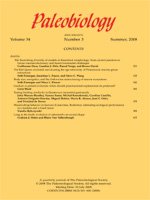Persistent fossil taxa contravene paradigms of evolution: pervasive morphological change and taxic turnover. Comparative studies of taxic duration have often been approached from biogeographic, climatic, and ecological perspectives, with a focus on process. Here I use a morphological approach to study the pattern of longevity of a large family of marine living and fossil podocopid ostracodes, Trachyleberididae sensu lato. I test if geologically longer-lived genera are collectively morphologically more deviant from a group mean than their shorter-lived relatives by using both discrete morphological data and outline data. I discovered that long-lived genera are in general not significantly more or less morphologically deviant from the average morphology than their shorter-lived relatives. However, I found that contemporaneous subsets of long-lived trachyleberidids are often at least marginally significantly more deviant in discrete morphology than shorter-lived ones, especially in external morphology. No significant patterns of association between morphological deviation and durations in other subdivisions of the data emerged (i.e., whole data set, birth cohorts, groups of morphological characters, and outline data using both Fourier analysis and eigenshape analysis). This is in contrast to a previous finding that long-lived genera of crinoids within orders are often morphologically less deviant than their shorter-lived relatives than expected by chance.
How to translate text using browser tools
1 January 2006
Do deviants live longer? Morphology and longevity in trachyleberidid ostracodes
Lee Hsiang Liow
ACCESS THE FULL ARTICLE

Paleobiology
Vol. 32 • No. 1
January 2006
Vol. 32 • No. 1
January 2006




